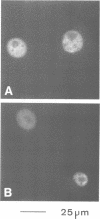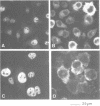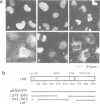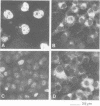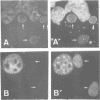Abstract
The nuclear localization of the progesterone receptor is mediated by two signal sequences: one is constitutive and lies in the hinge region (between the DNA and steroid binding domains), the other is hormone dependent and is localized in the second zinc finger of the DNA binding domain. The use of various inhibitors of energy synthesis in cells expressing permanently or transiently the wild-type receptor or a receptor mutated within the nuclear localization signals, demonstrated that the nuclear residency of the receptor reflects a dynamic situation: the receptor diffusing into the cytoplasm and being constantly and actively transported back into the nucleus. The existence of this nucleo-cytoplasmic shuttle mechanism was confirmed by receptor transfer from one nucleus to the other in heterokaryons. Preliminary evidence was obtained, using oestrogen receptor, that this phenomenon may be of general significance for steroid receptors.
Full text
PDF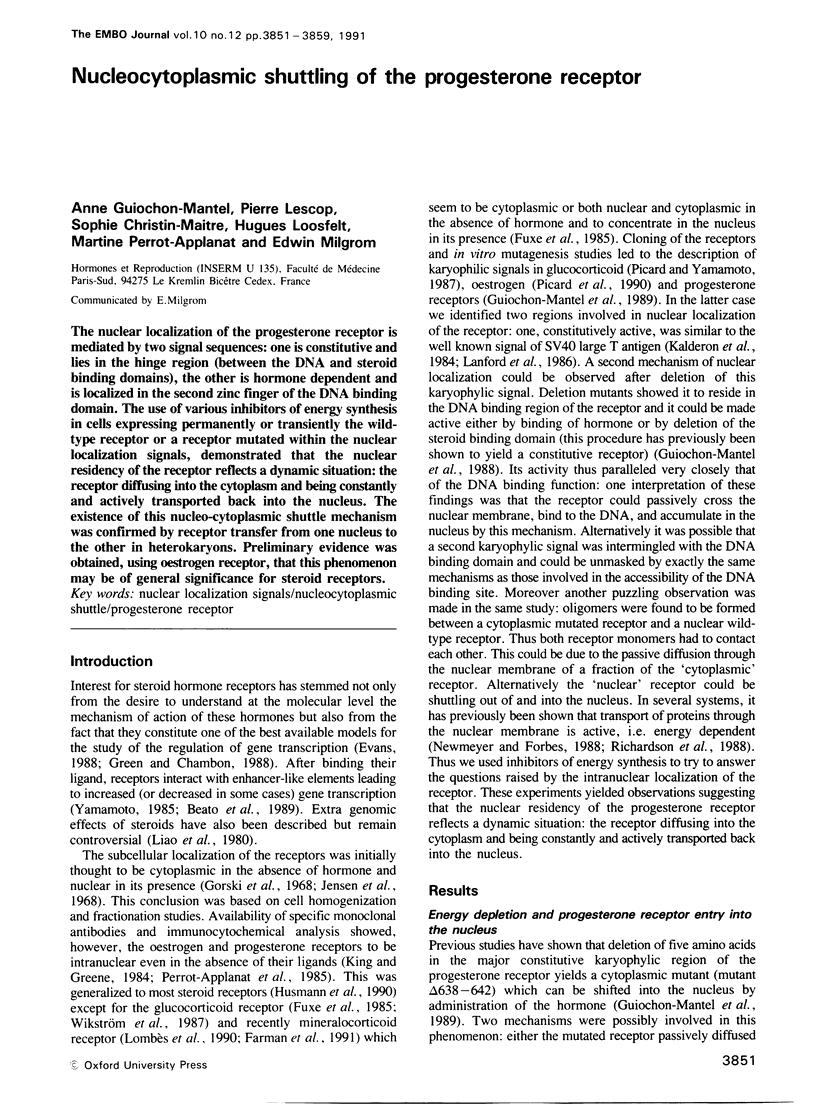
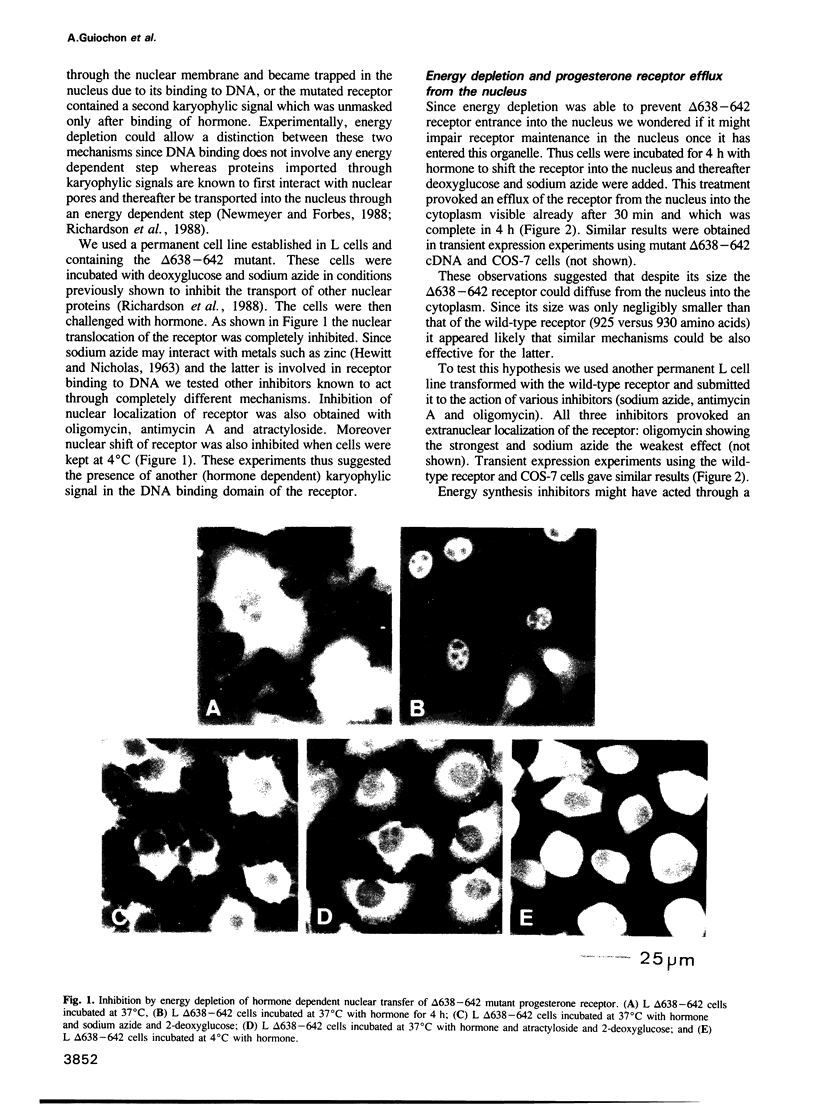
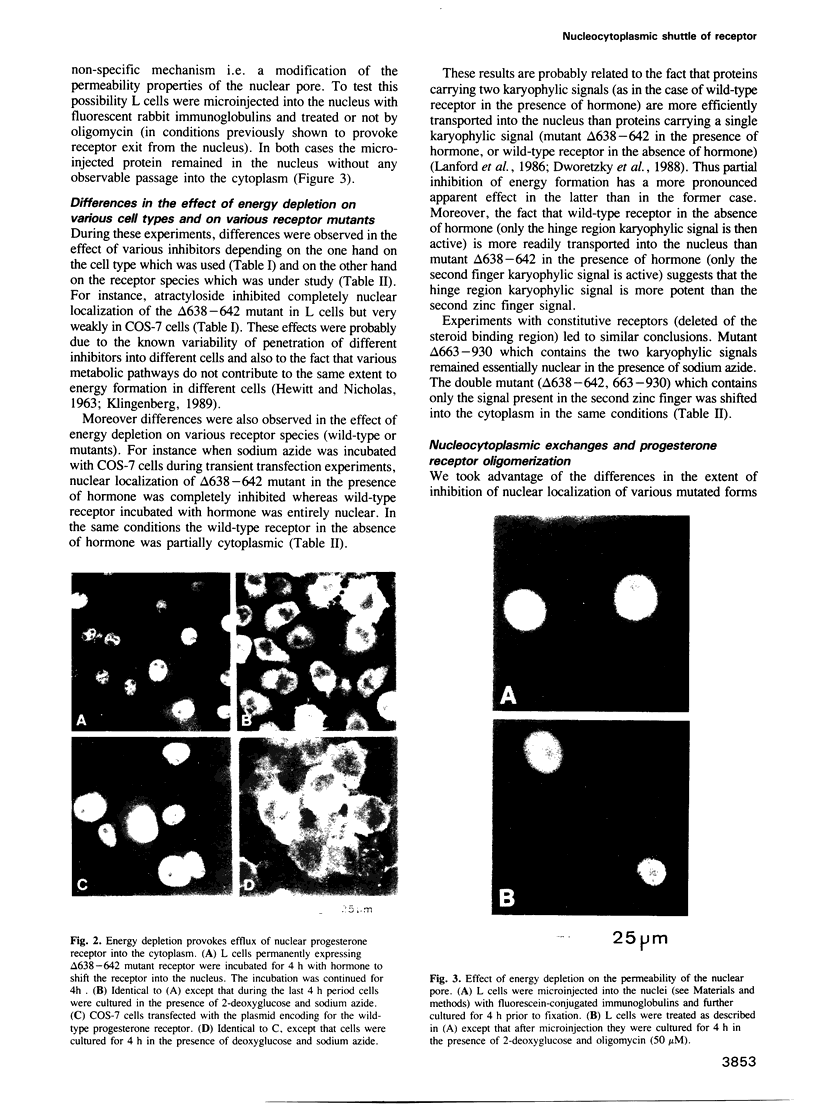
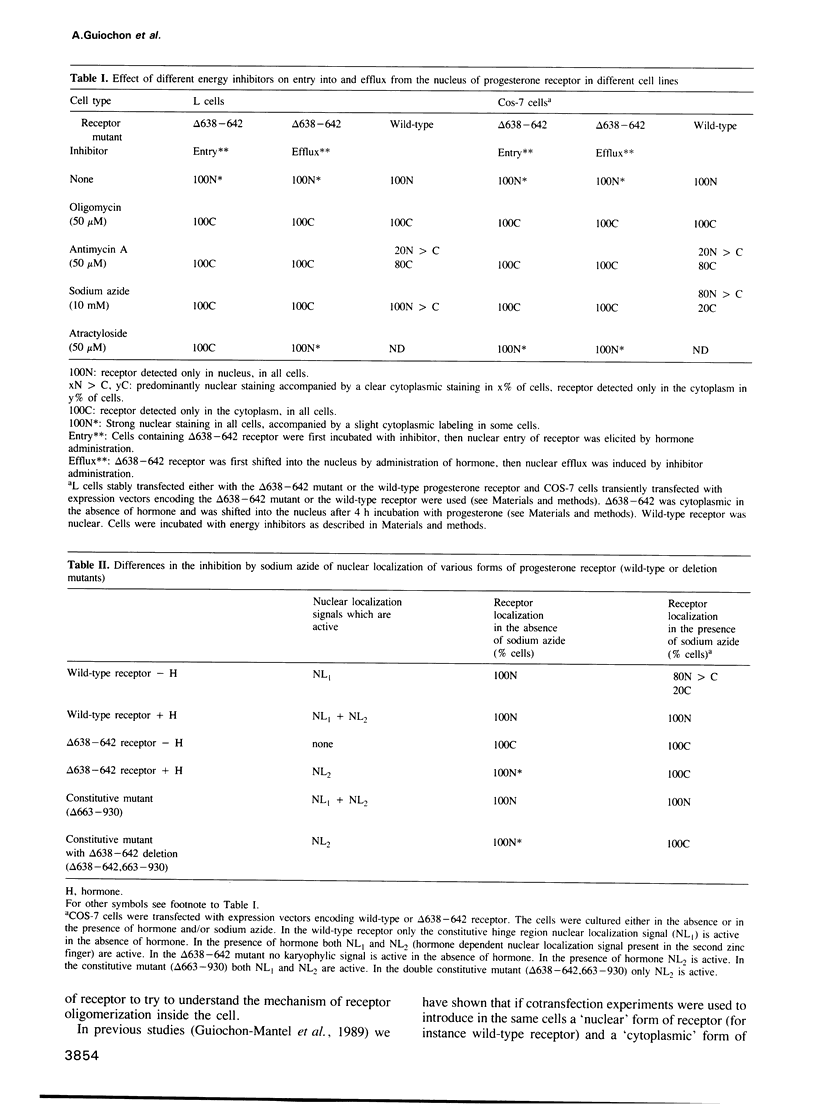
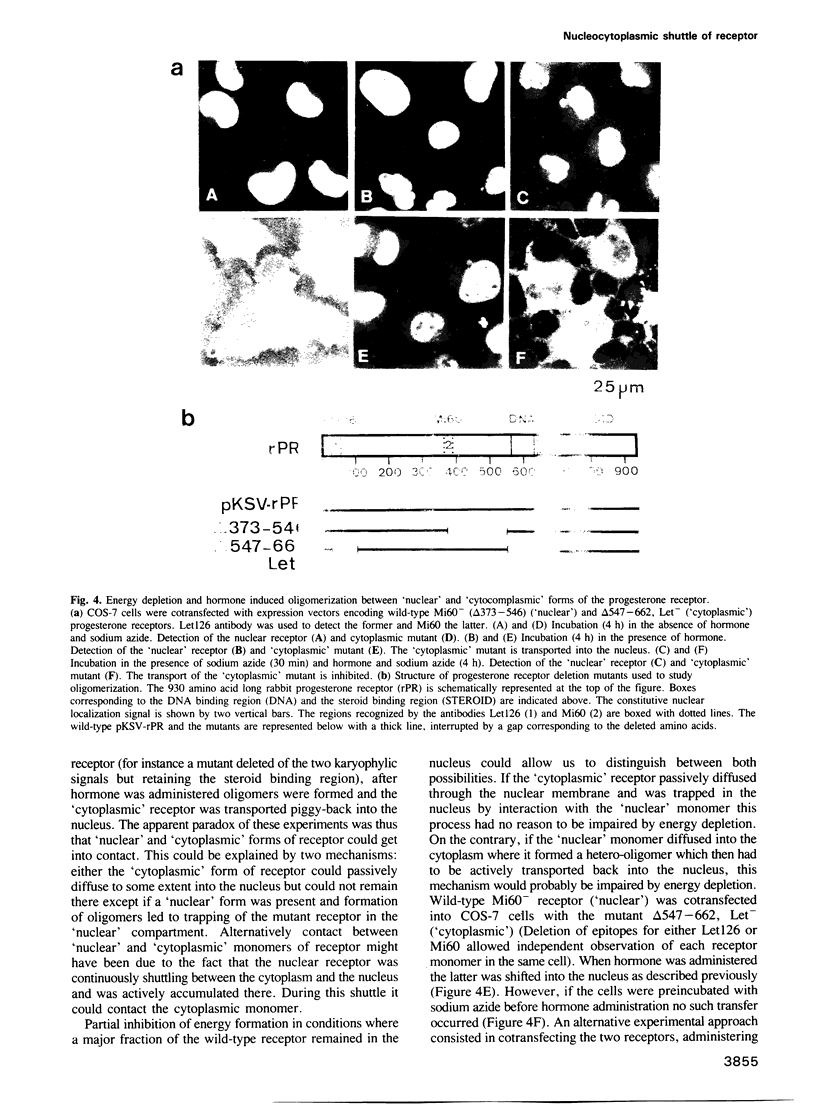
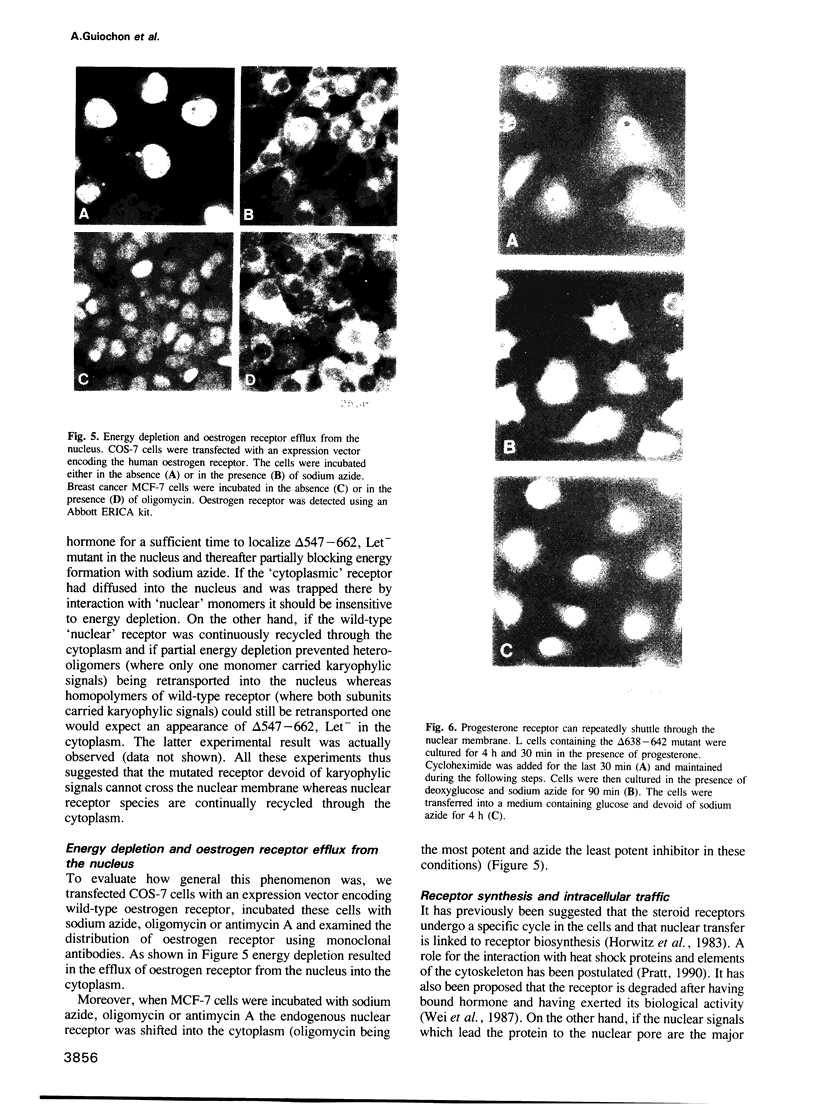
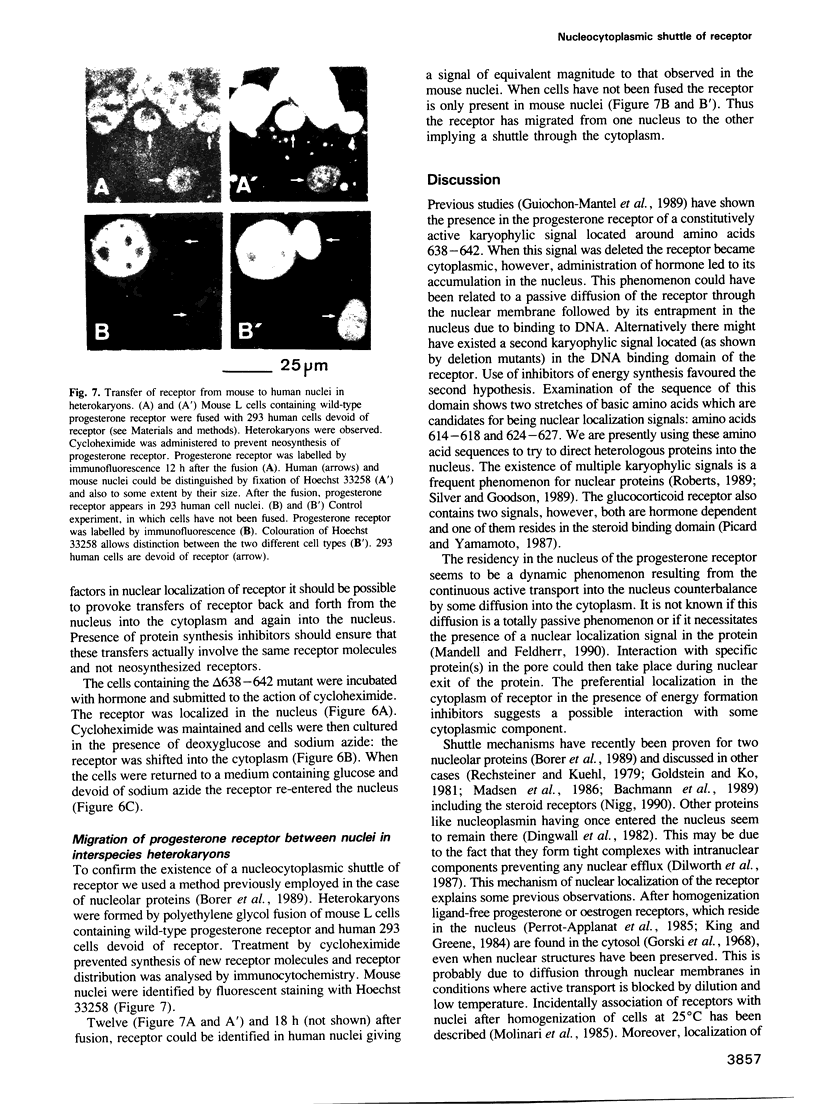
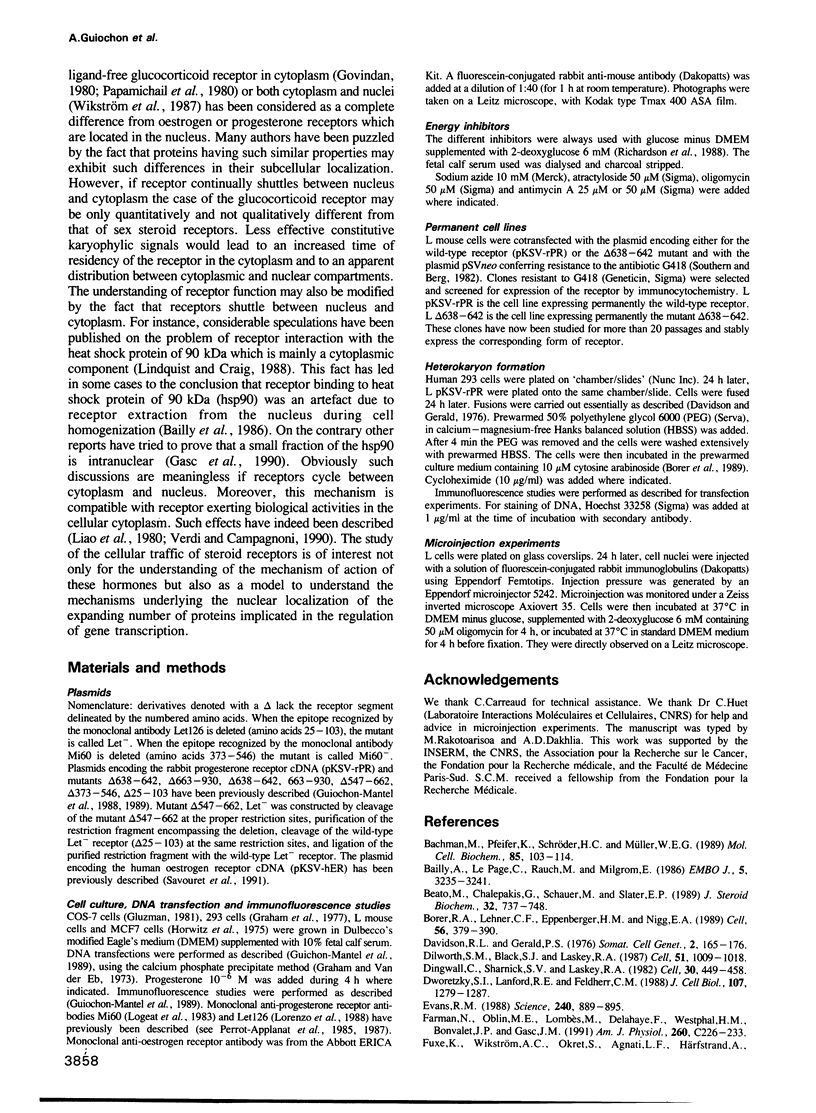
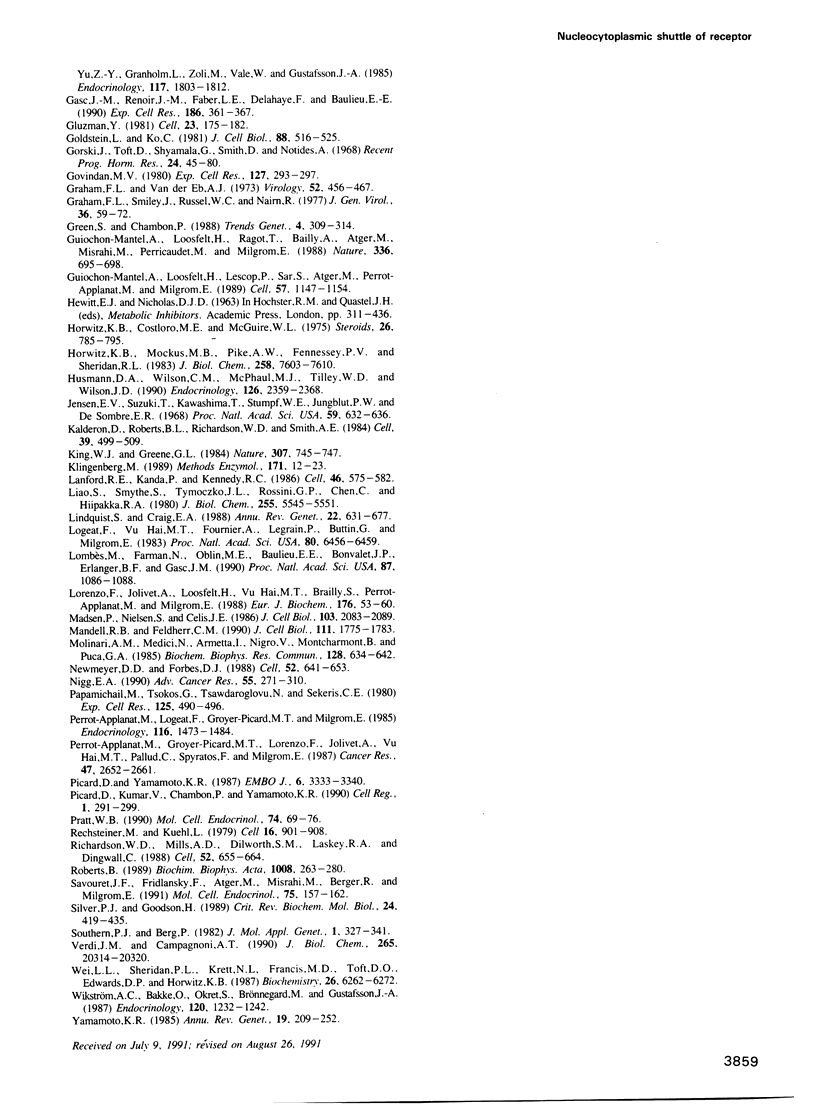
Images in this article
Selected References
These references are in PubMed. This may not be the complete list of references from this article.
- Bachmann M., Pfeifer K., Schröder H. C., Müller W. E. The La antigen shuttles between the nucleus and the cytoplasm in CV-1 cells. Mol Cell Biochem. 1989 Feb 21;85(2):103–114. doi: 10.1007/BF00577106. [DOI] [PubMed] [Google Scholar]
- Bailly A., Le Page C., Rauch M., Milgrom E. Sequence-specific DNA binding of the progesterone receptor to the uteroglobin gene: effects of hormone, antihormone and receptor phosphorylation. EMBO J. 1986 Dec 1;5(12):3235–3241. doi: 10.1002/j.1460-2075.1986.tb04634.x. [DOI] [PMC free article] [PubMed] [Google Scholar]
- Beato M., Chalepakis G., Schauer M., Slater E. P. DNA regulatory elements for steroid hormones. J Steroid Biochem. 1989 May;32(5):737–747. doi: 10.1016/0022-4731(89)90521-9. [DOI] [PubMed] [Google Scholar]
- Borer R. A., Lehner C. F., Eppenberger H. M., Nigg E. A. Major nucleolar proteins shuttle between nucleus and cytoplasm. Cell. 1989 Feb 10;56(3):379–390. doi: 10.1016/0092-8674(89)90241-9. [DOI] [PubMed] [Google Scholar]
- Davidson R. L., Gerald P. S. Improved techniques for the induction of mammalian cell hybridization by polyethylene glycol. Somatic Cell Genet. 1976 Mar;2(2):165–176. doi: 10.1007/BF01542629. [DOI] [PubMed] [Google Scholar]
- Dilworth S. M., Black S. J., Laskey R. A. Two complexes that contain histones are required for nucleosome assembly in vitro: role of nucleoplasmin and N1 in Xenopus egg extracts. Cell. 1987 Dec 24;51(6):1009–1018. doi: 10.1016/0092-8674(87)90587-3. [DOI] [PubMed] [Google Scholar]
- Dingwall C., Sharnick S. V., Laskey R. A. A polypeptide domain that specifies migration of nucleoplasmin into the nucleus. Cell. 1982 Sep;30(2):449–458. doi: 10.1016/0092-8674(82)90242-2. [DOI] [PubMed] [Google Scholar]
- Dworetzky S. I., Lanford R. E., Feldherr C. M. The effects of variations in the number and sequence of targeting signals on nuclear uptake. J Cell Biol. 1988 Oct;107(4):1279–1287. doi: 10.1083/jcb.107.4.1279. [DOI] [PMC free article] [PubMed] [Google Scholar]
- Evans R. M. The steroid and thyroid hormone receptor superfamily. Science. 1988 May 13;240(4854):889–895. doi: 10.1126/science.3283939. [DOI] [PMC free article] [PubMed] [Google Scholar]
- Farman N., Oblin M. E., Lombes M., Delahaye F., Westphal H. M., Bonvalet J. P., Gasc J. M. Immunolocalization of gluco- and mineralocorticoid receptors in rabbit kidney. Am J Physiol. 1991 Feb;260(2 Pt 1):C226–C233. doi: 10.1152/ajpcell.1991.260.2.C226. [DOI] [PubMed] [Google Scholar]
- Fuxe K., Wikström A. C., Okret S., Agnati L. F., Härfstrand A., Yu Z. Y., Granholm L., Zoli M., Vale W., Gustafsson J. A. Mapping of glucocorticoid receptor immunoreactive neurons in the rat tel- and diencephalon using a monoclonal antibody against rat liver glucocorticoid receptor. Endocrinology. 1985 Nov;117(5):1803–1812. doi: 10.1210/endo-117-5-1803. [DOI] [PubMed] [Google Scholar]
- Gasc J. M., Renoir J. M., Faber L. E., Delahaye F., Baulieu E. E. Nuclear localization of two steroid receptor-associated proteins, hsp90 and p59. Exp Cell Res. 1990 Feb;186(2):362–367. doi: 10.1016/0014-4827(90)90317-4. [DOI] [PubMed] [Google Scholar]
- Gluzman Y. SV40-transformed simian cells support the replication of early SV40 mutants. Cell. 1981 Jan;23(1):175–182. doi: 10.1016/0092-8674(81)90282-8. [DOI] [PubMed] [Google Scholar]
- Goldstein L., Ko C. Distribution of proteins between nucleus and cytoplasm of Amoeba proteus. J Cell Biol. 1981 Mar;88(3):516–525. doi: 10.1083/jcb.88.3.516. [DOI] [PMC free article] [PubMed] [Google Scholar]
- Gorski J., Toft D., Shyamala G., Smith D., Notides A. Hormone receptors: studies on the interaction of estrogen with the uterus. Recent Prog Horm Res. 1968;24:45–80. doi: 10.1016/b978-1-4831-9827-9.50008-3. [DOI] [PubMed] [Google Scholar]
- Govindan M. V. Immunofluorescence microscopy of the intracellular translocation of glucocorticoid-receptor complexes in rat hepatoma (HTC) cells. Exp Cell Res. 1980 Jun;127(2):293–297. doi: 10.1016/0014-4827(80)90435-8. [DOI] [PubMed] [Google Scholar]
- Graham F. L., Smiley J., Russell W. C., Nairn R. Characteristics of a human cell line transformed by DNA from human adenovirus type 5. J Gen Virol. 1977 Jul;36(1):59–74. doi: 10.1099/0022-1317-36-1-59. [DOI] [PubMed] [Google Scholar]
- Graham F. L., van der Eb A. J. A new technique for the assay of infectivity of human adenovirus 5 DNA. Virology. 1973 Apr;52(2):456–467. doi: 10.1016/0042-6822(73)90341-3. [DOI] [PubMed] [Google Scholar]
- Green S., Chambon P. Nuclear receptors enhance our understanding of transcription regulation. Trends Genet. 1988 Nov;4(11):309–314. doi: 10.1016/0168-9525(88)90108-4. [DOI] [PubMed] [Google Scholar]
- Guiochon-Mantel A., Loosfelt H., Lescop P., Sar S., Atger M., Perrot-Applanat M., Milgrom E. Mechanisms of nuclear localization of the progesterone receptor: evidence for interaction between monomers. Cell. 1989 Jun 30;57(7):1147–1154. doi: 10.1016/0092-8674(89)90052-4. [DOI] [PubMed] [Google Scholar]
- Guiochon-Mantel A., Loosfelt H., Ragot T., Bailly A., Atger M., Misrahi M., Perricaudet M., Milgrom E. Receptors bound to antiprogestin from abortive complexes with hormone responsive elements. Nature. 1988 Dec 15;336(6200):695–698. doi: 10.1038/336695a0. [DOI] [PubMed] [Google Scholar]
- Horwitz K. B., Costlow M. E., McGuire W. L. MCF-7; a human breast cancer cell line with estrogen, androgen, progesterone, and glucocorticoid receptors. Steroids. 1975 Dec;26(6):785–795. doi: 10.1016/0039-128x(75)90110-5. [DOI] [PubMed] [Google Scholar]
- Horwitz K. B., Mockus M. B., Pike A. W., Fennessey P. V., Sheridan R. L. Progesterone receptor replenishment in T47D human breast cancer cells. Roles of protein synthesis and hormone metabolism. J Biol Chem. 1983 Jun 25;258(12):7603–7610. [PubMed] [Google Scholar]
- Husmann D. A., Wilson C. M., McPhaul M. J., Tilley W. D., Wilson J. D. Antipeptide antibodies to two distinct regions of the androgen receptor localize the receptor protein to the nuclei of target cells in the rat and human prostate. Endocrinology. 1990 May;126(5):2359–2368. doi: 10.1210/endo-126-5-2359. [DOI] [PubMed] [Google Scholar]
- Jaeggi-Groisman S. E., Keller S., Zimmerli B., Meier P. J., Froesch E. R. Polar surface distribution of type II insulin-like growth factor receptor in rat hepatocytes. Mol Cell Endocrinol. 1990 Nov 12;74(1):69–74. doi: 10.1016/0303-7207(90)90206-n. [DOI] [PubMed] [Google Scholar]
- Jensen E. V., Suzuki T., Kawashima T., Stumpf W. E., Jungblut P. W., DeSombre E. R. A two-step mechanism for the interaction of estradiol with rat uterus. Proc Natl Acad Sci U S A. 1968 Feb;59(2):632–638. doi: 10.1073/pnas.59.2.632. [DOI] [PMC free article] [PubMed] [Google Scholar]
- Kalderon D., Roberts B. L., Richardson W. D., Smith A. E. A short amino acid sequence able to specify nuclear location. Cell. 1984 Dec;39(3 Pt 2):499–509. doi: 10.1016/0092-8674(84)90457-4. [DOI] [PubMed] [Google Scholar]
- King W. J., Greene G. L. Monoclonal antibodies localize oestrogen receptor in the nuclei of target cells. Nature. 1984 Feb 23;307(5953):745–747. doi: 10.1038/307745a0. [DOI] [PubMed] [Google Scholar]
- Klingenberg M. Survey of carrier methodology: strategy for identification, isolation, and characterization of transport systems. Methods Enzymol. 1989;171:12–23. doi: 10.1016/s0076-6879(89)71005-3. [DOI] [PubMed] [Google Scholar]
- Lanford R. E., Kanda P., Kennedy R. C. Induction of nuclear transport with a synthetic peptide homologous to the SV40 T antigen transport signal. Cell. 1986 Aug 15;46(4):575–582. doi: 10.1016/0092-8674(86)90883-4. [DOI] [PubMed] [Google Scholar]
- Lindquist S., Craig E. A. The heat-shock proteins. Annu Rev Genet. 1988;22:631–677. doi: 10.1146/annurev.ge.22.120188.003215. [DOI] [PubMed] [Google Scholar]
- Lino S., Smythe S., Tymoczko J. L., Rossini G. P., Chen C., Hiipakka R. A. RNA-dependent release of androgen and other steroidreceptor complexes from DNA. J Biol Chem. 1980 Jun 25;255(12):5545–5551. [PubMed] [Google Scholar]
- Logeat F., Vu Hai M. T., Fournier A., Legrain P., Buttin G., Milgrom E. Monoclonal antibodies to rabbit progesterone receptor: crossreaction with other mammalian progesterone receptors. Proc Natl Acad Sci U S A. 1983 Nov;80(21):6456–6459. doi: 10.1073/pnas.80.21.6456. [DOI] [PMC free article] [PubMed] [Google Scholar]
- Lombès M., Farman N., Oblin M. E., Baulieu E. E., Bonvalet J. P., Erlanger B. F., Gasc J. M. Immunohistochemical localization of renal mineralocorticoid receptor by using an anti-idiotypic antibody that is an internal image of aldosterone. Proc Natl Acad Sci U S A. 1990 Feb;87(3):1086–1088. doi: 10.1073/pnas.87.3.1086. [DOI] [PMC free article] [PubMed] [Google Scholar]
- Lorenzo F., Jolivet A., Loosfelt H., Thu vu Hai M., Brailly S., Perrot-Applanat M., Milgrom E. A rapid method of epitope mapping. Application to the study of immunogenic domains and to the characterization of various forms of rabbit progesterone receptor. Eur J Biochem. 1988 Sep 1;176(1):53–60. doi: 10.1111/j.1432-1033.1988.tb14250.x. [DOI] [PubMed] [Google Scholar]
- Madsen P., Nielsen S., Celis J. E. Monoclonal antibody specific for human nuclear proteins IEF 8Z30 and 8Z31 accumulates in the nucleus a few hours after cytoplasmic microinjection of cells expressing these proteins. J Cell Biol. 1986 Dec;103(6 Pt 1):2083–2089. doi: 10.1083/jcb.103.6.2083. [DOI] [PMC free article] [PubMed] [Google Scholar]
- Mandell R. B., Feldherr C. M. Identification of two HSP70-related Xenopus oocyte proteins that are capable of recycling across the nuclear envelope. J Cell Biol. 1990 Nov;111(5 Pt 1):1775–1783. doi: 10.1083/jcb.111.5.1775. [DOI] [PMC free article] [PubMed] [Google Scholar]
- Molinari A. M., Medici N., Armetta I., Nigro V., Moncharmont B., Puca G. A. Particulate nature of the unoccupied uterine estrogen receptor. Biochem Biophys Res Commun. 1985 Apr 30;128(2):634–642. doi: 10.1016/0006-291x(85)90093-2. [DOI] [PubMed] [Google Scholar]
- Newmeyer D. D., Forbes D. J. Nuclear import can be separated into distinct steps in vitro: nuclear pore binding and translocation. Cell. 1988 Mar 11;52(5):641–653. doi: 10.1016/0092-8674(88)90402-3. [DOI] [PubMed] [Google Scholar]
- Nigg E. A. Mechanisms of signal transduction to the cell nucleus. Adv Cancer Res. 1990;55:271–310. doi: 10.1016/s0065-230x(08)60471-6. [DOI] [PubMed] [Google Scholar]
- Papamichail M., Tsokos G., Tsawdaroglou N., Sekeris C. E. Immunocytochemical demonstration of glucocorticoid receptors in different cell types and their translocation from the cytoplasm to the cell nucleus in the presence of dexamethasone. Exp Cell Res. 1980 Feb;125(2):490–493. doi: 10.1016/0014-4827(80)90144-5. [DOI] [PubMed] [Google Scholar]
- Perrot-Applanat M., Groyer-Picard M. T., Lorenzo F., Jolivet A., Vu Hai M. T., Pallud C., Spyratos F., Milgrom E. Immunocytochemical study with monoclonal antibodies to progesterone receptor in human breast tumors. Cancer Res. 1987 May 15;47(10):2652–2661. [PubMed] [Google Scholar]
- Perrot-Applanat M., Logeat F., Groyer-Picard M. T., Milgrom E. Immunocytochemical study of mammalian progesterone receptor using monoclonal antibodies. Endocrinology. 1985 Apr;116(4):1473–1484. doi: 10.1210/endo-116-4-1473. [DOI] [PubMed] [Google Scholar]
- Picard D., Kumar V., Chambon P., Yamamoto K. R. Signal transduction by steroid hormones: nuclear localization is differentially regulated in estrogen and glucocorticoid receptors. Cell Regul. 1990 Feb;1(3):291–299. doi: 10.1091/mbc.1.3.291. [DOI] [PMC free article] [PubMed] [Google Scholar]
- Picard D., Yamamoto K. R. Two signals mediate hormone-dependent nuclear localization of the glucocorticoid receptor. EMBO J. 1987 Nov;6(11):3333–3340. doi: 10.1002/j.1460-2075.1987.tb02654.x. [DOI] [PMC free article] [PubMed] [Google Scholar]
- Rechsteiner M., Kuehl L. Microinjection of the nonhistone chromosomal protein HMG1 into bovine fibroblasts and HeLa cells. Cell. 1979 Apr;16(4):901–908. doi: 10.1016/0092-8674(79)90105-3. [DOI] [PubMed] [Google Scholar]
- Richardson W. D., Mills A. D., Dilworth S. M., Laskey R. A., Dingwall C. Nuclear protein migration involves two steps: rapid binding at the nuclear envelope followed by slower translocation through nuclear pores. Cell. 1988 Mar 11;52(5):655–664. doi: 10.1016/0092-8674(88)90403-5. [DOI] [PubMed] [Google Scholar]
- Roberts B. Nuclear location signal-mediated protein transport. Biochim Biophys Acta. 1989 Aug 14;1008(3):263–280. doi: 10.1016/0167-4781(89)90016-x. [DOI] [PubMed] [Google Scholar]
- Savouret J. F., Fridlanski F., Atger M., Misrahi M., Berger R., Milgrom E. Origin of the high constitutive level of progesterone receptor in T47-D breast cancer cells. Mol Cell Endocrinol. 1991 Feb;75(2):157–162. doi: 10.1016/0303-7207(91)90230-p. [DOI] [PubMed] [Google Scholar]
- Silver P., Goodson H. Nuclear protein transport. Crit Rev Biochem Mol Biol. 1989;24(4):419–435. doi: 10.3109/10409238909082557. [DOI] [PubMed] [Google Scholar]
- Southern P. J., Berg P. Transformation of mammalian cells to antibiotic resistance with a bacterial gene under control of the SV40 early region promoter. J Mol Appl Genet. 1982;1(4):327–341. [PubMed] [Google Scholar]
- Verdi J. M., Campagnoni A. T. Translational regulation by steroids. Identification of a steroid modulatory element in the 5'-untranslated region of the myelin basic protein messenger RNA. J Biol Chem. 1990 Nov 25;265(33):20314–20320. [PubMed] [Google Scholar]
- Wei L. L., Sheridan P. L., Krett N. L., Francis M. D., Toft D. O., Edwards D. P., Horwitz K. B. Immunologic analysis of human breast cancer progesterone receptors. 2. Structure, phosphorylation, and processing. Biochemistry. 1987 Sep 22;26(19):6262–6272. doi: 10.1021/bi00393a046. [DOI] [PubMed] [Google Scholar]
- Wikström A. C., Bakke O., Okret S., Brönnegård M., Gustafsson J. A. Intracellular localization of the glucocorticoid receptor: evidence for cytoplasmic and nuclear localization. Endocrinology. 1987 Apr;120(4):1232–1242. doi: 10.1210/endo-120-4-1232. [DOI] [PubMed] [Google Scholar]
- Yamamoto K. R. Steroid receptor regulated transcription of specific genes and gene networks. Annu Rev Genet. 1985;19:209–252. doi: 10.1146/annurev.ge.19.120185.001233. [DOI] [PubMed] [Google Scholar]




